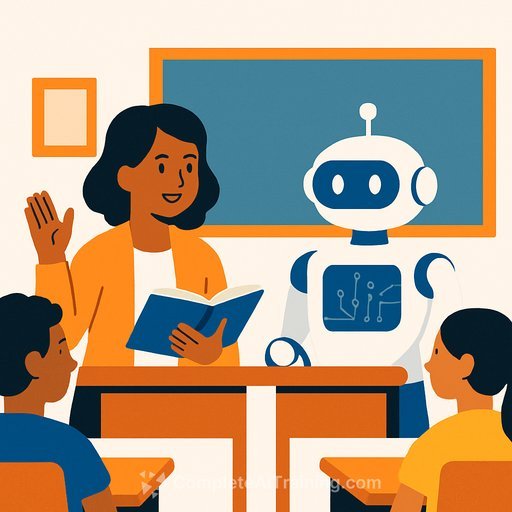AI vs. Education: Outsourcing Learning Won't Work - But Smart Use Will
Handing learning over to AI breaks the core of education. Generative tools produce answers on demand, but students need to learn how to learn, how to question, and how to build a personal base of knowledge. No tool can replace that process.
The outrage in staff rooms is justified. AI can make weak work look polished. It can also make nonsense look credible. Without structure and standards, we end up grading output, not thinking.
Why "answers on demand" clash with how people learn
- Learning is a process: inquiry, evaluation, synthesis, and reflection.
- AI compresses that into a single step: request → response.
- Students who skip the process don't develop transferable skills. They collect words, not knowledge.
- The burger analogy fits: ordering a meal doesn't make you a chef; prompting a model doesn't make you a thinker.
The epistemology angle: what counts as knowledge?
This isn't "kids are cheating with AI." It's about what we call knowledge in the first place. Epistemology asks how we know what we know, and that lens exposes the gap between original and assisted thinking. If a system manufactures plausible text, is that knowledge-or just output?
For a clear primer on epistemology, see the Stanford Encyclopedia of Philosophy overview. It's a helpful frame for policy and assessment design.
What teachers can't see (and must make visible)
- Is the student doing the thinking, or outsourcing it?
- Do they understand your question, or just the prompt pattern?
- Can they apply critical thinking, or only repeat a polished answer?
If you can't observe the process, you can't assess learning. The fix is to design tasks that surface reasoning, decisions, and checks.
A quick self-test
Pick a random topic. Ask an AI for a summary. Notice how fast you accept it. If you don't verify facts, compare sources, or test the claims, you're dependent. Students are no different-and often less equipped to see what's missing.
Bad inputs compound. Gaps stay hidden until a lab, a test, or a real-world task exposes them.
The practical path forward: AI as a training partner, not a substitute
The solution isn't prohibition. It's structure. Treat AI like a lab instrument: useful, auditable, and bounded by standards.
1) Design assignments that surface original thinking
- Require process artifacts: research logs, drafts, prompt history, and revision notes.
- Use personal or local data: class-collected datasets, school case studies, or field notes AI cannot invent.
- Add short oral defenses: 3-5 minute explanations of key choices, tradeoffs, and sources.
- Use in-class "AI-off" phases: quick writes, whiteboard proofs, or closed-laptop quizzes.
- Ask for annotated sources: why each source was chosen, how it was verified, and what was rejected.
- Include model comparison: students test two systems, note differences, and justify their final stance.
2) Normalize transparent AI use with clear rules
- Include an AI use statement on every assignment: which uses are allowed, which are not, and what must be disclosed.
- Split work into "AI-on" and "AI-off" phases: brainstorming vs. final synthesis, outline vs. original proof.
- Set a citation convention for AI: model name, date, purpose, and prompts used.
- Penalize hidden AI use, not honest, bounded use that follows rules.
3) Prefer accredited, academic-grade AI systems
- Require retrieval with citations and source links rather than pure generative claims.
- Align models to your curriculum: glossaries, reading lists, standards, and rubrics.
- Demand audit trails: logs of prompts, edits, and time-on-task for compliance and appeals.
- Set contract terms: data privacy, bias testing, uptime SLAs, content filters, and opt-out from model training.
- Pilot with sandbox classes and run comparative testing against known question banks.
UNESCO's work on AI in education offers useful policy context. Start here: UNESCO: AI and Education.
4) Test the systems like a skeptical examiner
- Red-team prompts: look for confident nonsense, missing steps, and fake citations.
- Measure against learning objectives, not word count or style.
- Add fairness checks: performance across reading levels, accommodations, and subject areas.
- Re-test after updates; models change and so do failure modes.
5) Build critical AI literacy in students and staff
- Teach verification: claim → evidence → counter-evidence → conclusion.
- Use structured skepticism: "What would falsify this?" "Which sources disagree?"
- Practice prompt hygiene: constraints, definitions, and step-by-step reasoning requests.
- Model the workflow live: show your own checks, dead ends, and revisions.
6) Assessment patterns that work
- Two-step submissions: AI-assisted prep at home; synthesis, transfer, or application in class.
- Frequent low-stakes checks: quick oral quizzes or reasoning spot-checks.
- Portfolio evidence: growth over time, with reflection on what changed and why.
- Capstone with community or client: real constraints make shallow work obvious.
7) A minimal policy checklist for schools
- Acceptable use matrix by grade level and subject.
- Disclosure rules and consequences for non-disclosure.
- Data privacy, storage, and consent practices.
- Accessibility and accommodations baked in from day one.
- Annual review: update tools, prompts, and assessments based on evidence.
What good looks like
Students use AI to plan, compare sources, and stress-test ideas. They verify facts, track decisions, and present their own reasoning. Teachers get visibility into the process and grade thinking, not polish.
That's the standard worth pursuing. Outsourcing learning fails. Using AI to raise the bar on evidence and clarity works.
Further practical resources
- Curated AI courses and certifications for job roles in education: Complete AI Training: Courses by Job
- Keep up with new classroom-ready tooling and practices: Latest AI Courses
AI isn't a shortcut to knowledge. It's a tool for better questions, clearer reasoning, and stronger evidence-if we build the guardrails and teach the process.
Your membership also unlocks:






